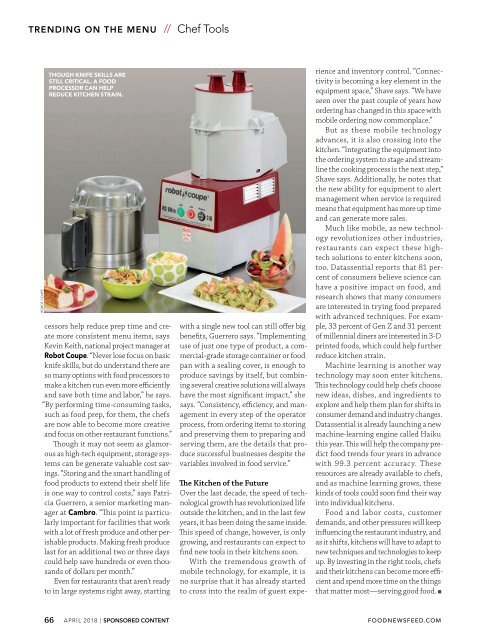FSR magazine April 2018
Create successful ePaper yourself
Turn your PDF publications into a flip-book with our unique Google optimized e-Paper software.
Trending on The menu // Chef Tools<br />
RoboT Coupe<br />
Though knife skills aRe<br />
sTill CRiTiCal, a food<br />
pRoCessoR Can help<br />
ReduCe kiTChen sTRain.<br />
cessors help reduce prep time and create<br />
more consistent menu items, says<br />
Kevin Keith, national project manager at<br />
Robot Coupe. “Never lose focus on basic<br />
knife skills, but do understand there are<br />
so many options with food processors to<br />
make a kitchen run even more efficiently<br />
and save both time and labor,” he says.<br />
“By performing time-consuming tasks,<br />
such as food prep, for them, the chefs<br />
are now able to become more creative<br />
and focus on other restaurant functions.”<br />
Though it may not seem as glamorous<br />
as high-tech equipment, storage systems<br />
can be generate valuable cost savings.<br />
“Storing and the smart handling of<br />
food products to extend their shelf life<br />
is one way to control costs,” says Patricia<br />
Guerrero, a senior marketing manager<br />
at Cambro. “This point is particularly<br />
important for facilities that work<br />
with a lot of fresh produce and other perishable<br />
products. Making fresh produce<br />
last for an additional two or three days<br />
could help save hundreds or even thousands<br />
of dollars per month.”<br />
Even for restaurants that aren’t ready<br />
to in large systems right away, starting<br />
with a single new tool can still offer big<br />
benefits, Guerrero says. “Implementing<br />
use of just one type of product, a commercial-grade<br />
storage container or food<br />
pan with a sealing cover, is enough to<br />
produce savings by itself, but combining<br />
several creative solutions will always<br />
have the most significant impact,” she<br />
says. “Consistency, efficiency, and management<br />
in every step of the operator<br />
process, from ordering items to storing<br />
and preserving them to preparing and<br />
serving them, are the details that produce<br />
successful businesses despite the<br />
variables involved in food service.”<br />
The Kitchen of the Future<br />
Over the last decade, the speed of technological<br />
growth has revolutionized life<br />
outside the kitchen, and in the last few<br />
years, it has been doing the same inside.<br />
This speed of change, however, is only<br />
growing, and restaurants can expect to<br />
find new tools in their kitchens soon.<br />
With the tremendous growth of<br />
mobile technology, for example, it is<br />
no surprise that it has already started<br />
to cross into the realm of guest experience<br />
and inventory control. “Connectivity<br />
is becoming a key element in the<br />
equipment space,” Shave says. “We have<br />
seen over the past couple of years how<br />
ordering has changed in this space with<br />
mobile ordering now commonplace.”<br />
But as these mobile technology<br />
advances, it is also crossing into the<br />
kitchen. “Integrating the equipment into<br />
the ordering system to stage and streamline<br />
the cooking process is the next step,”<br />
Shave says. Additionally, he notes that<br />
the new ability for equipment to alert<br />
management when service is required<br />
means that equipment has more up time<br />
and can generate more sales.<br />
Much like mobile, as new technology<br />
revolutionizes other industries,<br />
restaurants can expect these hightech<br />
solutions to enter kitchens soon,<br />
too. Datassential reports that 81 percent<br />
of consumers believe science can<br />
have a positive impact on food, and<br />
research shows that many consumers<br />
are interested in trying food prepared<br />
with advanced techniques. For example,<br />
33 percent of Gen Z and 31 percent<br />
of millennial diners are interested in 3-D<br />
printed foods, which could help further<br />
reduce kitchen strain.<br />
Machine learning is another way<br />
technology may soon enter kitchens.<br />
This technology could help chefs choose<br />
new ideas, dishes, and ingredients to<br />
explore and help them plan for shifts in<br />
consumer demand and industry changes.<br />
Datassential is already launching a new<br />
machine-learning engine called Haiku<br />
this year. This will help the company predict<br />
food trends four years in advance<br />
with 99.3 percent accuracy. These<br />
resources are already available to chefs,<br />
and as machine learning grows, these<br />
kinds of tools could soon find their way<br />
into individual kitchens.<br />
Food and labor costs, customer<br />
demands, and other pressures will keep<br />
influencing the restaurant industry, and<br />
as it shifts, kitchens will have to adapt to<br />
new techniques and technologies to keep<br />
up. By investing in the right tools, chefs<br />
and their kitchens can become more efficient<br />
and spend more time on the things<br />
that matter most—serving good food.<br />
66 ApRil <strong>2018</strong> | SPonSored ConTenT FOODNEWSFEED.cOm



